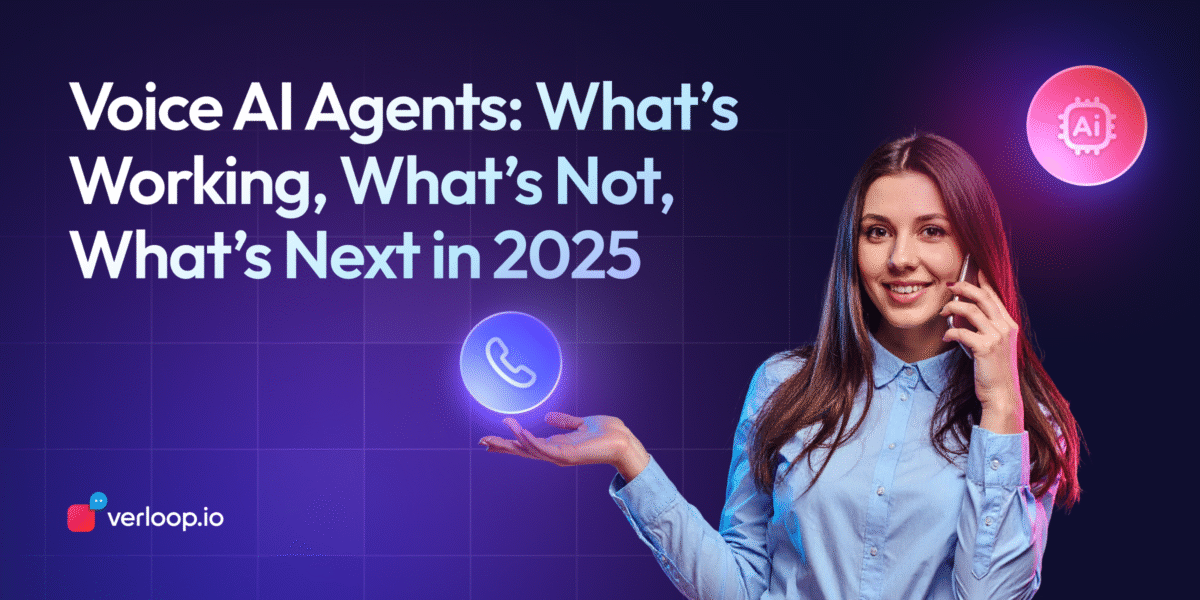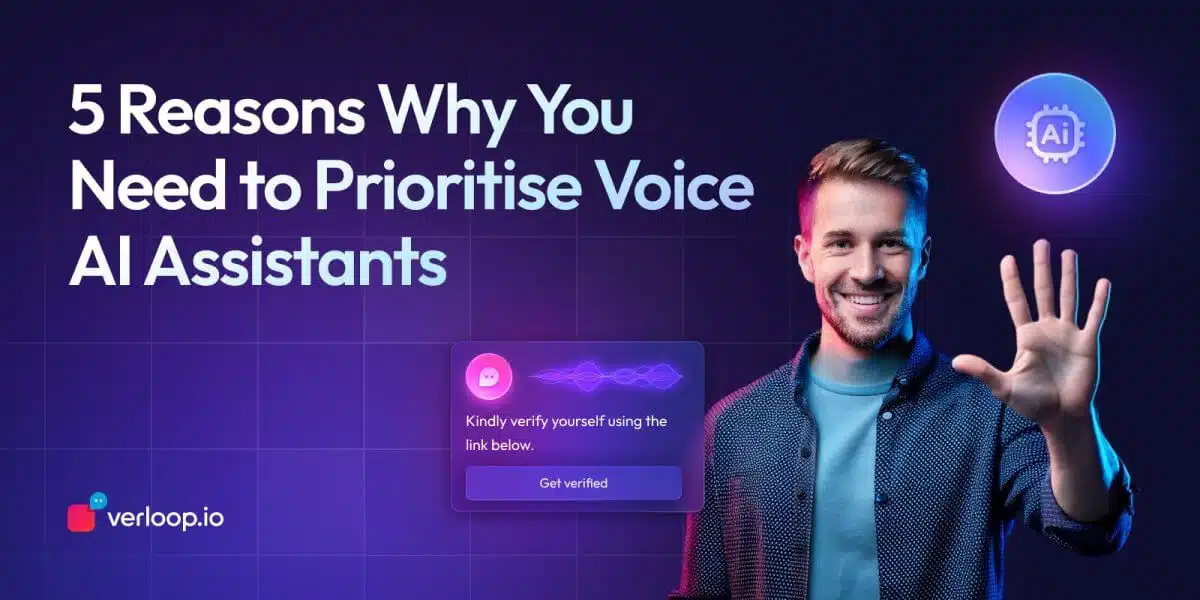
Voice AI Agents: What’s Working, What’s Not, What’s Next in 2025
- June 18th, 2025 / 5 Mins read
- Harshitha Raja
Let’s say a man calls his bank.
He wants to break his Fixed Deposit and withdraw the amount. A fairly simple, routine request. The agent helps him with it. Identity verified, amount confirmed, transaction completed.
The customer got what he came for. The agent did their job. Everyone’s satisfied.
But let’s rewind a bit.
While mentioning his request, the customer mentioned the reason he’s withdrawing the amount. He’s getting married.
Now that’s a deeply personal and insightful detail. What did your agent do with this? Your agent may have smiled, maybe even congratulated him. But what happens next?
Nothing. The detail is gone as soon as the call ended. Not because your agent didn’t care, but because they were already on to the next call.
Now let’s look at the same call being handled by a voice AI agent.
The request is still processed. But this time, when the customer mentions the wedding, the voice agent picks it up.
It doesn’t just hear it. It remembers.
That one line turns into a future action, a follow-up with something timely like a spouse credit card, or a family insurance plan.
Now this agent didn’t just close the request, but opened up potential future synergies.
This is the real power of voice AI in 2025. It’s why 86% of organisations see voice AI as a key driver for more accessible and inclusive customer experiences.
And this is exactly what the best brands are aiming for, not more calls handled, but better conversations had and more delightful customer experiences delivered.
In this blog this is exactly what we’ll be talking about, voice AI technology. Let’s see what are the advantages, bottlenecks, and what’s next in 2025.
What’s Working? How Is Voice AI Already Delivering Value?
84% of organisations plan to increase their budgets for voice technology over the next 12 months.
And this tells you only one thing. This is the space people are betting on because budgets don’t move without results.
So let’s look at what’s actually working on the ground.
From IVRs to Intelligent Follow-Ups
Let’s rewind to how most outbound calls looked until recently.
Earlier, banks relied on IVR systems to handle routine outbound calls from EMI reminders and loan follow-ups to KYC alerts. If the customer didn’t press the right key or hung up, it only meant dropped calls or missed payments.
Now, however, things are different with voice AI.
Let’s say your customer picks up. The voice agent reminds them about an overdue EMI. The customer says they’ve been out of work for a few months and can’t pay this week.
Earlier, that’s where the call ended. But now? The AI acknowledges it. Flags it. And triggers a follow-up workflow, or a restructure plan eligibility check or maybe a callback request from a human agent, say a collections in charge.
So now, it’s not just scripted, hit or miss reminder calls anymore. Today, voice AI enables you to incorporate very dynamic, personalised customer conversations into your customer service strategy.
Turning Missed Deliveries into Confirmed Drop-Offs
If you’re in logistics, you already know how fragile delivery windows are. Every missed call or wrong address meant suddenly you’re dealing with a delayed parcel, a frustrated customer, and a very stressed-out support team.
Before Voice AI, your agents would waste so much time on this mundane “rescheduling delivery” task. And this costs the business time and financial loss. The agents’ time is both being paid for and being wasted on handling tasks such as these, which do not typically require human involvement.
Here, your voice AI agent could step in the moment a delivery fails.
The customer picks up. The agent apologises and asks for a better delivery time. The customer selects a slot. It gets confirmed right there and pushed to your delivery partner.
And even if the customer doesn’t pick up? The system can retry later, intelligently. All without a single human spending time on it.
From Repeat Calls to Resolved Scheduling
Imagine you run a diagnostic lab or a multispecialty hospital. You have hundreds of appointments a day, and just as many reschedules, no-shows, and confirmation calls.
Earlier, your human agents were constantly calling patients. “Are you still coming?”, “Do you want to reschedule?”, “Can we confirm your insurance details?”
Some patients wouldn’t answer, and others would pick up but ask the same set of questions over and over again.
Once again, this leads to agents’ lost time and patients getting frustrated.
Now, when Voice AI takes over this layer:
A patient receives a call. The voice agent confirms their appointment for the next day. They say they need to push it by two days. The AI agent reschedules on the spot, checks doctor availability, and confirms it with a new date and time. It can even remind them of documents to carry or send directions via WhatsApp.
Result? Your human team can now focus on more sensitive, ‘human attention-demanding’ issues.
Answering 'Where is my order?' Before They Even Ask
Proactive support. It’s more than just a keyword that’s trending today.
In 2025, as businesses aim to deliver better customer experiences, proactive customer service is at the top of the checklist.
Let’s take an example of E-commerce. If you’re in e-commerce, your support teams have likely spent hours each day answering the same thing:
“Where is my order?”
With human agents, implementing proactive support to reduce the number of delivery enquiry tickets coming in would have been such a difficult task.
But today, with Voice AI, this ticket is handled even before it hits your support screens.
Let’s say a delay happens due to weather. The voice agent automatically reaches out, informs the customer, apologises for the delay, and even offers a small store credit.
The customer feels seen. The issue is handled. And your agents? They’re finally freed up to solve things that actually need human context.
Scaling Demo Confirmations Without Missing a Beat
Let’s talk missed opportunities now, every business’s pain point.
Let’s take an example of the Edtech industry.
In edtech, every demo missed is a potential conversion lost.
Before Voice AI, your teams were stretched thin calling every lead, confirming demos, chasing payments, and answering the same 3–4 questions daily.
But with a voice AI agent, that entire first layer of effort is handled for you.
Let’s say a parent registers interest for a coding class for their child. The voice agent calls them, confirms the slot, reminds them on the day of the demo, and answers basic doubts about fees or curriculum.
And if the parent says they’re unsure, the agent doesn’t push. It tags the lead and triggers a callback from a live rep.
Result?
Your team now only handles warm leads and isn’t busy with cold follow-ups or missed confirmations.
Pre-Qualify Leads Before a Human Ever Steps In
Imagine an insurance sales team.
They rely heavily on conversations, and their tasks and KPIs are very time-bound.
An insurance agent’s biggest stress is meeting targets. And one thing that doesn’t help him at all here is each taking up 10-15 minutes of his workday.
An agent’s tasks previously were to call every number. Ask five to six qualifying questions. Enter data manually.
And most of it led nowhere. Leading to unproductive, poor-performing and burnt-out agents.
Now, a voice AI agent does this first step. It calls the lead, asks the right questions and captures information about their age, income, intent, location, etc. Based on these responses, it qualifies or disqualifies them.
And only the filtered leads, the ones with genuine intent, reach your agents.
What’s Not Working? Challenges Still Being Tackled by Voice AI
Let’s be clear, no technology is perfect. Especially one as complex as voice.
But the good news? The best voice AI solutions aren’t ignoring any issues or challenges.
Here’s where most friction shows up today, and why it shouldn’t stop you from moving forward.
1. Latency
Let’s address the elephant in the room.
Today, when everyone is talking about AI agents, the most common and popular challenge that’s being discussed about voice AI agents in particular is the lag.
That half-second delay before a voice agent responds. That slight pause after the customer says something.
Now, this used to be one of the biggest blockers for teams exploring voice AI. Especially in real-time support and in fast-paced markets like India and the UAE.
But here’s where things are changing.
With newer models and faster architecture, that lag is now coming down, from multiple seconds to even under a second in many cases.
The difference is significant. And if you’re working with a platform that’s focused on speech optimisation and real-time processing, this is already a challenge that’s on its way out.
2. Robotic Tone
Another common challenge with voice AI is that it sounds too robotic.
Yes, this is still the case with many solutions today. With certain voice AI solutions, sometimes it sounds flat. Or too stiff. Or just… AI.
And the risk is clear. If it doesn’t sound human, the customer won’t engage.
But again, this is not a dead end.
At Verloop.io, we approach this very differently. We’ve built in speech normalisation and custom speech profiles, so your agent’s tone can adapt to your brand, your use case, and even your region.
We train models in multiple languages and even dialects.
Take Tamil, for example. A Chennai-based customer might speak Tamil differently than someone based in Coimbatore. Same language but different rhythm, different words and different flow.
A generic solution won’t get this right, whereas a trained voice agent will.
3. Multilingual Conversations
Let’s take an example from the UAE.
Customers start in English. Shift to Emirati English. Drop in some Arabic. Then back to English again.
This is where older voice systems get confused. If the sentence structure shifts mid-conversation, the response can fall apart.
But this is also where voice AI is rapidly improving. With language models now being trained on blended speech patterns and real-life call data, agents are becoming better at switching context mid-sentence and still staying accurate.
So yes, multilingual intent detection and personalising the conversation accordingly is already improving fast. And it’s already workable today with the right setup.
4. Integrations
A voice agent is only as smart as the systems it connects to.
If it can’t talk to your CRM or fetch real-time customer data, it can’t deliver a great experience, no matter how human it sounds.
A few years ago, this was a serious challenge. Integration required a lot of technical help and took weeks, if not months.
But now? Good platforms don’t ask you to change your stack or take weeks to integrate with it. They integrate with your tools quickly and is up and running.
5. Sensitive Cases
No matter how well you train an AI, someone, somewhere, will say something unexpected.
They’ll go off-topic. They’ll bring up a new issue mid-call. Or they’ll respond in a way that the model didn’t predict.
Earlier, this would cause the agent to restart the script. Or even worse, say, “Sorry, I didn’t understand that,” on repeat.
Today, with memory models and real-time contextual awareness improving, agents can now stay on track even during such detours.
And these advanced models know exactly when and how to hand over to a human agent with full context of the conversation.
And the best part? Such cases are often used to retrain the system. So what doesn’t work today often becomes tomorrow’s strength.
Once again, this isn’t a blocker. It’s a part of the training process for the system.
What’s Next? Voice AI Advancements For 2025
According to Statista, the Global Voice AI Agents Market size is expected to be worth around USD 47.5 Billion By 2034, from USD 2.4 billion in 2024, growing at a CAGR of 34.8% during the forecast period from 2025 to 2034.
That kind of growth doesn’t happen without real innovation.
By now, we’ve seen how Voice AI technology has proved its worth by maturing into a system that doesn’t just handle support but enables better customer experiences, drives retention, and aids in creating better revenue opportunities.
However, the capabilities of voice AI don’t end here. Let’s take a look at what’s on the horizon and why it matters to you.
- Voice-Driven Workflow Execution: Voice agents will start executing complex backend workflows such as raising tickets, initiating refunds, updating KYC, generating PDF statements, etc., triggered entirely by what’s said on the call. This helps in further reducing human intervention and scope for manual error.
- Dynamic Persona Shifting Based on Caller Segment: Your AI agent is being trained to not sound the same to everyone. Voice agents will dynamically shift vocabulary, tone, and phrasing, all based on real-time segmentation and CRM tags. For example, a Gen Z caller might hear a casual tone, whereas a senior customer gets a slower, more formal pace.
- Voice Agents Feeding Into Voice-of-Customer (VoC) Intelligence: Beyond service, your voice agents will become your largest source of unfiltered customer feedback. Aggregated tone, keyword trends, repeated objections and much more could all be turned into actionable VoC dashboards, straight from real customer conversations.
- Zero-Shot Intent Handling With Guardrails: Voice AI systems will no longer need pre-training for every single use case. Voice agents will increasingly use zero-shot or few-shot LLMs to handle new intents without needing full retraining, while staying within pre-defined enterprise-safe limits.
Getting Voice AI Working Inside Your Business
85% of enterprises and 78% of SMBs plan to adopt AI voice agents in 2026. And 70% expect clear, measurable benefits from integrating voice AI across multiple customer touchpoints.
If you’re one of them, the next step isn’t research. It’s rollout.
At Verloop.io, we work with CX teams to make Voice AI live where it matters most for them, be it Inbound support, outbound workflows, multilingual, personalised conversations at scale, or compliance-ready automation.
Curious to see what that could look like for you? Let’s walk through it together.
Book a demo today!






